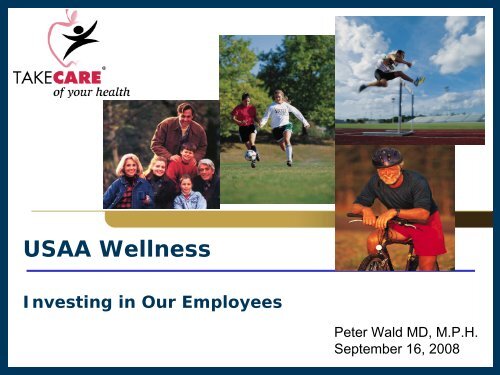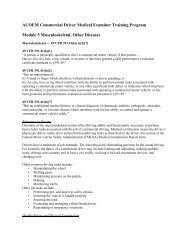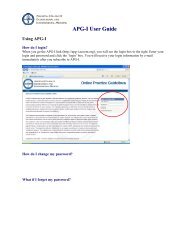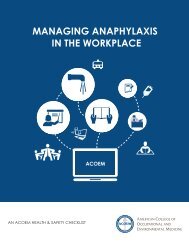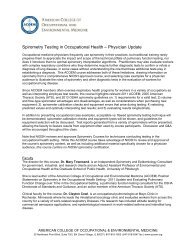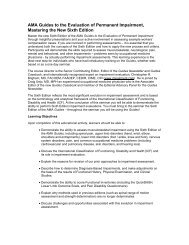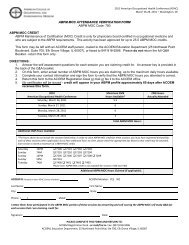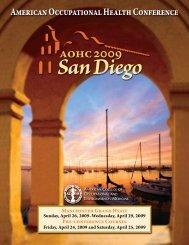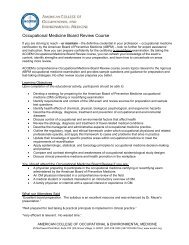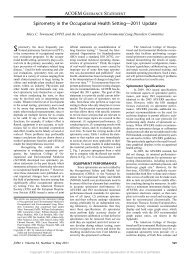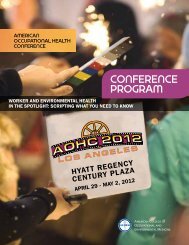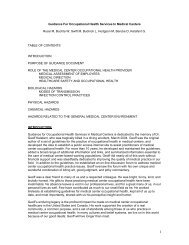Wald, Peter. USAA Wellness
Wald, Peter. USAA Wellness
Wald, Peter. USAA Wellness
Create successful ePaper yourself
Turn your PDF publications into a flip-book with our unique Google optimized e-Paper software.
<strong>USAA</strong> <strong>Wellness</strong>Investing in Our Employees<strong>Peter</strong> <strong>Wald</strong> MD, M.P.H.September 16, 2008
<strong>USAA</strong>2006 C. Everett Koop National Health Award-sole winnerComprehensive, multi-discipline, and integrated health & productivity management program(healthproject.stanford.edu).22,000 employees, 14,000 in TexasDiversified financial services companyThe leading provider of competitively priced financial planning, insurance, investments, andbanking products to members of the U.S. military and their families.6.5 million members rely on the convenience and accessibility of <strong>USAA</strong> financial products backedby industry-leading service.#1 Business Week Customer Service 2007 and 2008.The company was founded in 1922.2
<strong>Wellness</strong> and our Benefits StrategyOur people are our most important resource.Our focus is employee productivity.Keeping employees healthy through primary prevention (<strong>Wellness</strong>).We are “investing” in our employees and building a wellness “culture”for the long term.We are encouraging and supporting behavior change.<strong>Wellness</strong> is integrated into our benefits.We want to maximize health and quality of life for employees and theirfamilies so we can better serve our members.We monitor program efficacy.We want to keep doing what works and stop doing what doesn’t work.Executive management briefed before implementation thatthere is a 3-5 year delay for financial returns.3
<strong>USAA</strong> population health summary•Healthy employees use less<strong>USAA</strong> resources.–85% of employees use 20% of resources–12.5% of employees use 40% of resources–2.5% of employees use 40% of resources•Employee overall cost trend areflat while dependent costscontinue to rise.•50-80*% of total costs arerelated to behaviors associatedwith preventable diseases.–Smoking–Physical Inactivity–Poor nutrition/obesity–Inattention to preventive practicesIndicators for high risk conditions.Glucose >110 7.7%Cholesterol>240 13.2%Cholesterol>200 43.6%Blood pressure>120/80 23.4%BMI >25 68.1%BMI >30 34.4%*Modifiable Behavioral Factors as Causes of Death JAMA. 20044
Integrated health benefits trend by risk group2.5%-> 40%12.5%-> 40%85%-> 20%Costs for high risk group are rising greater than other groupsAdjusted for Inflation5
Dependent costs are rising at a higher rateTop 5 Costs:•Musculoskeletal•Cancer•Maternity•Endocrine-Metabolic•CirculatoryAdjusted for inflationSuccessful employee wellness programs need to be extended to dependents.6
<strong>Wellness</strong> MessagesDon’t Smoke.Be Active.Eat Right.Prevention.<strong>Wellness</strong> doesn’t stop at work.7
Current <strong>Wellness</strong> Organization<strong>Wellness</strong>Clinical servicesIntegrated disability management<strong>Wellness</strong> programs.• <strong>Wellness</strong> Council.Data warehouse.<strong>Wellness</strong> CouncilSafety.Fitness and Recreation.Food services.Communications.Company store.Corporate Real Estate.Multiple Outsourced Vendors<strong>USAA</strong> is the integrator.Assembled “Best of Breed” programIndividually selected by RFP process.Completely internal selection process8
Key Program ElementsIdentityHealth Risk AssessmentsHealth Promotion ToolsFinancial IncentivesOn-site Fitness and RecreationHealthy Food ServicesPopulation Data AnalysisBuilding the “<strong>Wellness</strong> Culture.”9
InterveningSpecific ExamplesPopulationTargetedPreventive benefits ($300/y).<strong>Wellness</strong> benefits ($350+50/y).Smoking CessationFitnessWeight ManagementHRAs and biometrics.On-site fitness rebate (25/50/100%).Lifestyle change coaching.Individual Health ManagementNutrition counseling.BMI greater than 35.Integrated disability mgmt.Transitional duty.<strong>Wellness</strong> breaks.Nontraditional fitness and recreation.Calorie balance tool.Workplace safety (Be Safe).Healthy food services (The 4 P’s).Smoke-free campus.Contests and events10
Sustaining Management Commitment to <strong>Wellness</strong>Satisfaction.Participation.Risk factor reduction.Economic impact.Short-term gains in productivity and disability sustainmanagement commitment to longer-term gains that resultfrom healthier employees.11
HRA Participation- Gateway to <strong>Wellness</strong>14,00012,00012,36122,291uniqueparticipantshave takenan HRA sincethe programinception in200310,0008,0006,0004,00010,0204,8847,9829,8192,00002003/2004* 2005 2006 2007 2008***represents two campaigns**YTD Aug 6, 2008Participation increases employee awareness and ability to respond to risks.12
Two HRAs Risk ComparisonLeftward shiftshowsimprovement<strong>USAA</strong> risk profile is improving.N = 459313
<strong>Wellness</strong> participation impact to risk and costRisk ComparisonAt-Risk, Non-Participants At-Risk, Participants Not At-RiskRisk Factors32102.61.81.4Fitness2.5 2.41.8 1.8 1.7 1.61.3 1.41.6 1.51.0 1.0 1.0 0.9 1.0Smoking External Fitness Fitness Equipment Weight Mgmt On-Site Fitness Iow aCost ComparisonAt-Risk, Non-Participants At-Risk, Participants Not At-Risk$4,000Cost$3,000$2,000$1,000$0$2,789$3,299$2,469$2,724$2,313$2,172$2,869$2,312$2,173$2,631$2,803$2,221$2,748$2,461$1,776$3,701$3,373$2,205Smoking External Fitness Fitness Equipment Weight Mgmt On-Site Fitness Iow aParticipation in wellness programs decreases risks and generally lowers costs.14
BMI is highly correlated with risk and costBMI < 24.99 25 - 29.99 30 - 34.99 > 35N 4,156 4,787 2,761 2,266HRA Risks 1.14 1.30 2.59 2.83Average Cost $3,601 $3,813 $4,601 $5,744Impact of BMI on Medical Costs$7,000$6,000$5,000Medical Cost$4,000$3,000$2,000$1,000$0< 24.99 25 - 29.99 30 - 34.99 > 35BMIBMI has significant impact and needs to be a primary focus area.15
BMI association to notable health conditions20.0%17.2%** Significant Difference15.0%Percent of Claimants with Condition (Unadjusted)10.0%5.0%7.0%4.3%*9.7%*1.8%*0.8%2.5%1.5%*0.8%2.1%0.0%Biliary Tract Disease Hypertension Asthma CAD DiabetesOdds Ratio 2.01 Odds Ratio 2.75 Odds Ratio 1.97 Odds Ratio 1.98 Odds Ratio 5.16BMI>=30 BMI
We Need to Move Employees and Their Families to Healthy BMI.10% weight loss annuallyEmployee beginsBMI: 35End of 1 st yearBMI: 31.5End of 2 nd yearBMI: 28.4End of 3 rd yearBMI: 25.5!!Reducing weight by 10% annually dramatically improves BMI17
Investing in EmployeesKeeping healthy employees and their families healthy iscritical for all employers.All employers can benefit from a healthy workforce.Not all employers have our internal expertise, but manywould support <strong>Wellness</strong> programs if they could get somedirection and support from a trusted third party.NCQA’s <strong>Wellness</strong> and Health Promotion Accreditation willhelp employers purchase these services.Executive management support is critical for success.Program metrics are critical to allow senior managementto stay engaged18


